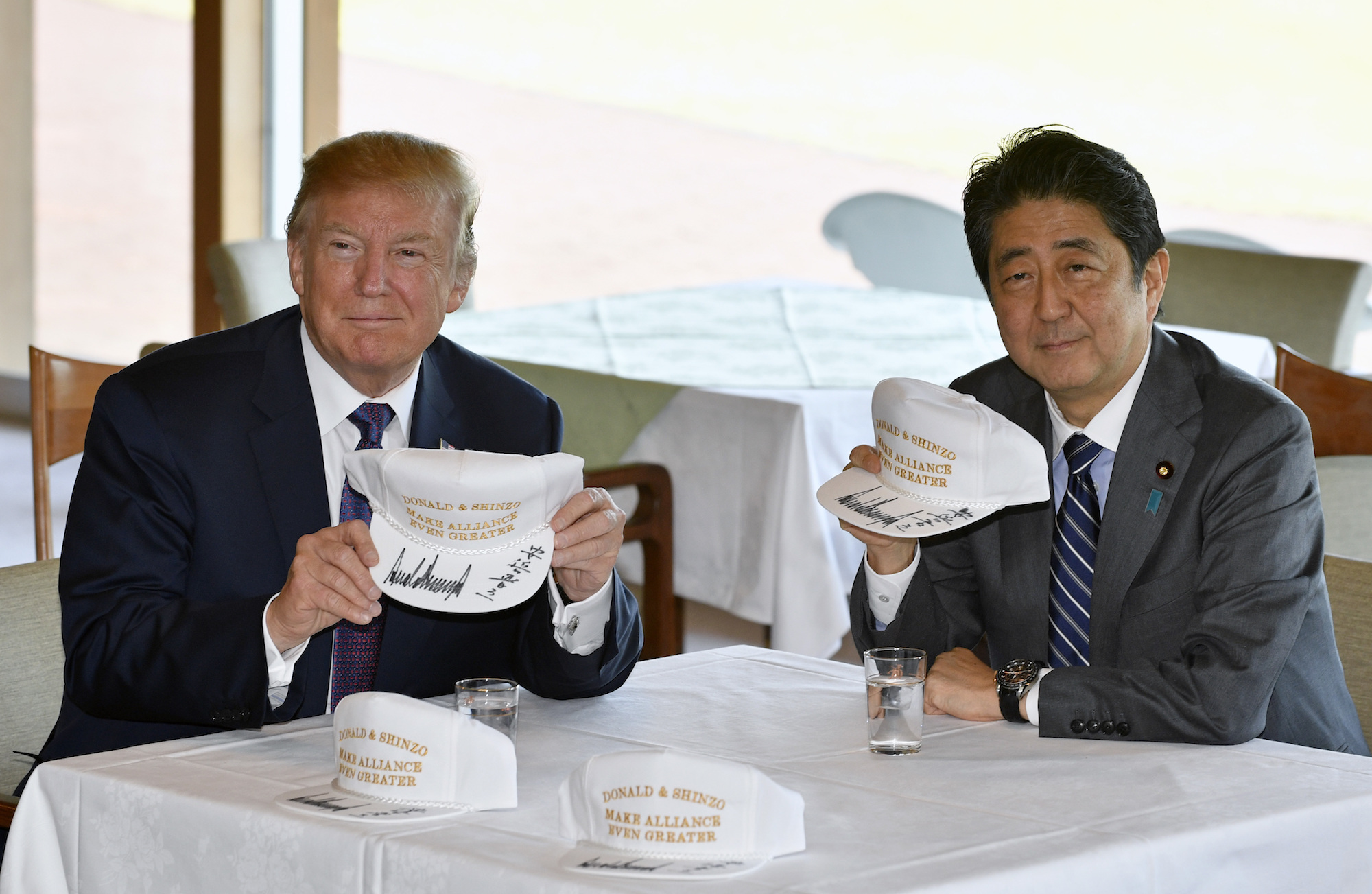- President Donald Trump has landed in Japan, the first Asian country he is visiting during his 12-day tour of the region. He is meeting with Prime Minister Shinzo Abe, who will host the US president for a meeting with families of Japanese citizens abducted by North Korea. Trump is also meeting with American and Japanese service members. Longstanding US allies in the Asia Pacific like Japan will likely be looking for signs of continued American support from Trump amid the ongoing North Korea crisis, especially since he pulled out of the Trans-Pacific Partnership trade agreement. Trump called Japan a “warrior nation” the day before he left for his trip.
US President Donald Trump has landed in Japan, the first Asian country he is visiting during his 12-day tour of the region.
Trump already golfed and dined with Prime Minister Shinzo Abe, who will host the US president for a meeting with families of Japanese citizens abducted by North Korea. Trump is also scheduled to meet with American and Japanese service members, and said shortly after landing that “it’s expected” he’ll meet with Russian President Vladimir Putin on the trip.
North Korea will undoubtedly be one of the topics discussed by Trump and Abe. During a congratulatory call after Japan’s recent snap elections, the two leaders reportedly discussed being united on the need to increase pressure on the regime.
Overall, Trump's Asia tour aims to "underscore his commitment to longstanding United States alliances and partnerships, and reaffirm United States leadership in promoting a free and open Indo-Pacific region," the White House said.
Playing golf with Prime Minister Abe and Hideki Matsuyama, two wonderful people! pic.twitter.com/vYLULe0o2K
— Donald J. Trump (@realDonaldTrump) November 5, 2017
But there are concerns in Asia about the degree to which the Trump administration is genuinely committed to the economic prosperity and security of the region, given Trump's sharp policy shifts from the previous administration.
Longstanding US allies in the Asia Pacific like Japan will likely be looking for signs of continued American support from Trump, especially since the American president pulled out of the Trans-Pacific Partnership (TPP) agreement, which was largely seen as a statement about the US's long-term commitment to the region.
Trump calls Japan a 'warrior nation'

The day before he departed for his trip, Trump called Japan a "warrior nation" and said China might have a "big problem with Japan pretty soon" over North Korea in an interview with Fox News Channel's "The Ingraham Angle."
"Well, you know Japan is a warrior nation. And I tell China and I tell everyone else that, listen, you're going to have yourself a big problem with Japan pretty soon if you allow this to continue with North Korea," Trump said during the interview.
He said that "of course" Japan is worried about North Korea and that "they should be worried. You know, they're very close to North Korea." But he also added that "China has been helping us" with the North Korea crisis.
Japan has formally been a pacifist nation since the end of the World War II. Japan's constitution, which came into effect in 1947 after the war, includes an article (which the US pushed to be added) that renounces war as a sovereign right of the nation and the threat or use of force as a means by which to settle international disputes. But Abe has made efforts to "remove pacifist constraints" on the military.
His ruling coalition recently won a more than two-thirds majority in snap elections. Abe is now set to be the longest-serving prime minister in postwar Japan, and is expected to use his new mandate to push for changes in the country's defense strategy, according to CNN.
His defense agenda has, arguably, been helped forward by the ongoing North Korea crisis, even though about half of poll respondents in Japan disagree with revising the pacifist clause. It's possible that if the US appears to pull out of regional disputes in Asia, Abe might be inspired to move his defense agenda forward.
'Indo-Pacific' versus 'Asia-Pacific'

Interestingly, Washington has long referred to the region the president is visiting as the "Asia-Pacific," but the Trump administration has instead opted to call it the "Indo-Pacific."
The AP suggested it might be an attempt to create more distance between Trump and his predecessor Barack Obama and his "Pivot to Asia" strategy, but the switch could also suggest that the administration wants to highlight that the region is more than just China's backyard. In fact, recently Secretary of State Rex Tillerson spoke about expanding ties with India, who had seen some tensions with China earlier this year, and about partnering with allies like Australia and Japan, as the AP notes.
However, it's notable that the moniker "Indo-Pacific" doesn't come with a unified economic plan. This is in contrast to the Trans-Pacific Partnership, which was supposed to lower tariffs for 12 countries around the Pacific Rim, including Japan and Mexico but excluding China. The trade agreement was negotiated under the Obama administration as an arm of its "Pivot to Asia," before the Trump administration announced its withdrawal.

